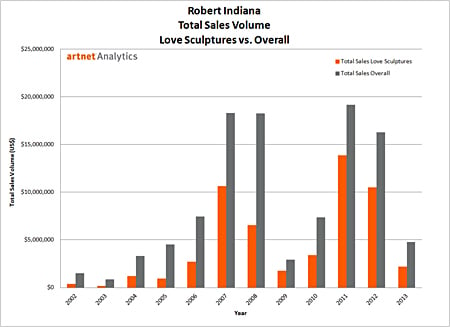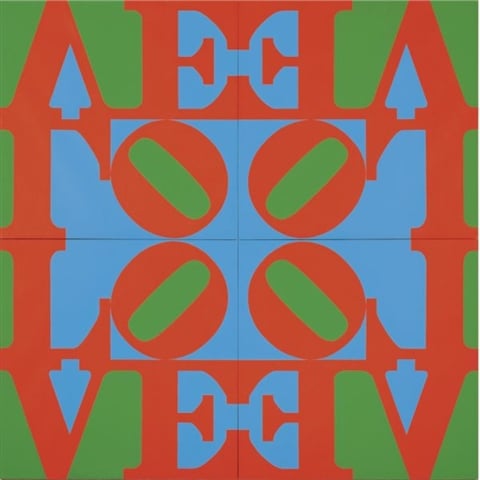Art & Exhibitions
Robert Indiana: It’s All About Love
A look at Robert Indiana’s most iconic sculpture, Love.

A look at Robert Indiana’s most iconic sculpture, Love.

Deborah Ripley

In September, the Whitney Museum of American Art opened the first United States retrospective for artist Robert Indiana (American, b.1928) entitled Beyond Love, examining the 85-year-old artist’s paintings and sculptures not associated with his most well-known image, Love. The 1964 graphic, spelling out the word “LOVE” in block typeface, was first linked to the anti-war era and love-ins, and was later reproduced on everything from t-shirts to key chains. The United States Postal Service even issued a Christmas Love stamp in 1973. As the Love image was copied ad nauseam, it became a tiresome cliché that eclipsed everything else created by the artist, who was viewed as a sell-out by art-world cognoscenti. In 1978, Indiana threw in the towel—he decamped to the island of Vinalhaven, Maine, where he has lived and worked in relative isolation ever since.
While the Whitney exhibition is garnering critical acclaim for uncovering the artist’s darker, more psychologically complex assemblages created in the 1960s, the auction world is still in love with Love, more specifically, the painted aluminum sculptures fabricated in the 1990s that reproduced the iconic 1960s Love image.

Robert Indiana Total Sales Volume (US$), Love Sculptures vs. Overall, 2002–2013
Data provided by artnet Analytics show that the percentage of sales volume represented by Love sculptures has increased substantially over the years. In 2002,Love sculptures represented 25% of the total sales volume, compared to 72% in 2011 and 64% in 2012. In addition to Love Wall (1968), which fetched US$2,841,000 at Sotheby’s in 2008, some of the highest prices ever paid for Indiana works at auction were for Love sculptures. The highest price ever achieved for the artist at auction was US$4,114,500 in 2011 for the largest sculpture—144.1 x 144.1 x 72 inches—in an edition of three. The second-highest price paid for a Love sculpture was for the third, larger sculpture in the same series, which was purchased for US$3,513,000 in 2007. The second sculpture—96 x 96 x 48 inches—fetched US$1,706,500 in 2012.

Robert Indiana, Love Wall—Red green blue (in 4 parts), 1966, oil on canvas, sold for US$2,841,000 at Sotheby’s New York

Robert Indiana, Love red/blue, 1990, painted aluminum, sold for US$4,114,500 at Christie’s New York
Indiana, who refers to himself as the “least Pop of all the Pop artists,” never cultivated a cult of personality like Andy Warhol (American, 1928–1987) or Roy Lichtenstein (American, 1923–1997), which may account for his undeservedly narrow scope of recognition.1 Although the Love sculptures are essentially reproductions of the iconic Love image, the magic of replicating other early works by the artist has not resulted in the same commercial success. A bronze reproduction of the 1960 wooden assemblage Orb (1960) has been at auction twice since its last sale nearly a decade ago, once in New York in 2008 with an estimate of US$150,000–200,000, and again in Paris in 2010 with an estimate of €200,000–250,000 (US$265,428–333,1785), and failed to sell on both occasions.

Robert Indiana, Orb, 1960, oil, iron wheels and iron on wood, sold for US$477,900 at Christie’s New York
Perhaps the Whitney retrospective will spark renewed interest in the artist’s earlier works, so that eventually, the market will reflect the breadth of the world’s last living Pop artist’s oeuvre, which to this point has been dominated by Love.
1 Paul Kasmin Gallery, Robert Indiana in the Wall Street Journal, October 3, 2013. Accessed October 8, 2013, http://www.paulkasmingallery.com/.